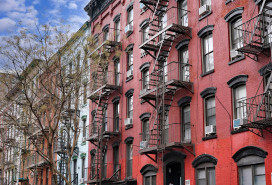Ask Sam: My ex is moving out. Does that mean my rent will go up when I renew my rent-stabilized lease?

Even if your partner moves out of your rent-stabilized apartment, as the remaining person on the lease, you have the right to renew it as a rent-stabilized tenant, says attorney Sam Himmelstein.
iStock
I live in a rent-stabilized apartment with my soon-to-be ex. Both of our names are on the lease, which is up for renewal early next year. If I stay, would the landlord have the right to charge me a new, higher rate because only my name will be on the lease?
Since your apartment is rent stabilized, your landlord can’t raise the rent by more than the amount set by the Rent Guidelines Board for a lease renewal, says Sam Himmelstein, a lawyer at Himmelstein, McConnell, Gribben & Joseph, who represents residential and commercial tenants and tenant associations.
Prior to 2019, when tenants moved out of a rent-stabilized apartment, the landlord could issue a new lease at a higher rate, and eventually, when the rent crossed a certain threshold, deregulate the apartment. This was known as vacancy deregulation, and it ended with the Housing Stability and Tenant Protection Act of 2019 (HSTPA). Now, even if tenants vacate a rent-stabilized apartment, the landlord can only increase the rent by amount set by the Rent Guidelines Board.
“Since HSTPA outlawed vacancy increases, it doesn’t really matter what kind of lease you get—the landlord can’t raise the rent by more than what would be permitted for renewal leases, except for a small increase capped at $89 per month if they renovate during a period of a vacancy,” Himmelstein says. “And even before HSTPA, as long as one of the tenants named on the lease renewed it, it would still be considered a renewal lease, not a new lease.”
The rates for renewals of rent-stabilized leases are set by the Rent Guidelines Board. For one-year renewals made between October 1st, 2022 and September 30th, 2023, landlords can increase the rent by 3.25 percent. For two-year renewals made within the same period, landlords can increase the rent by 5 percent.
“Your landlord can’t insist that both people named on the lease renew, and as the remaining person on the lease, you have the right to renew it as a rent-stabilized tenant,” Himmelstein says. “If the landlord gives you a hard time about it, you can file a complaint with the DHCR."
It’s also important to note that for both stabilized and market-rate leases, no matter how many tenants are named on the lease, each tenant is considered responsible for the entire rent—not just their portion of it. This means that if one tenant moves out, the remaining tenant is responsible for their share of the rent, as well as their own.
For this reason, since HSTPA, some landlords of rent-stabilized apartments may prefer having more than one tenant named on a lease.
“There are advantages to putting a couple on a lease—it gives the landlord another person he can go after for the full rent,” Himmelstein says. “When there are multiple people on the lease, each one can be held responsible for the full rent.”
Related:
Ask Sam: Two of my roommates moved out. Am I responsible for their rent? (sponsored)
Ask Sam: How much information do I have to give the landlord before I move in with my friend? (sponsored)
Ask Sam: I found out my apartment used to be rent stabilized. Now what? (sponsored)
Read all our Ask a Renters Rights Lawyer columns here.
Sam Himmelstein, Esq. represents NYC tenants and tenant associations in disputes over evictions, rent increases, rental conversions, rent stabilization law, lease buyouts, and many other issues. He is a partner at Himmelstein, McConnell, Gribben & Joseph in Manhattan. To submit a question for this column, click here. To ask about a legal consultation, email Sam or call (212) 349-3000.


























